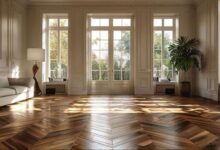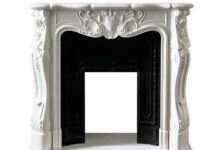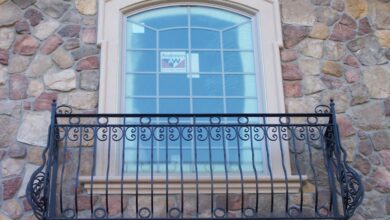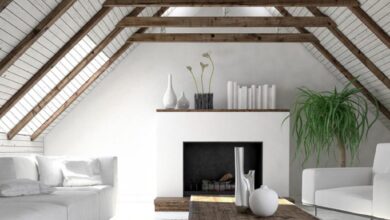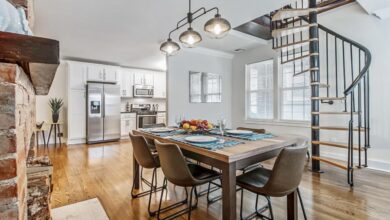French Windows A Complete Guide
French windows, those elegant floor-to-ceiling doors, offer more than just a stunning view; they’re a statement of architectural style and a gateway to seamless indoor-outdoor living. From their historical roots in grand European estates to their modern adaptations in contemporary homes, French windows have captivated homeowners for centuries with their ability to flood spaces with natural light and create a feeling of openness and connection to the surrounding environment.
This guide delves into the fascinating world of French windows, exploring their design, construction, maintenance, and energy efficiency, alongside considerations for accessibility and interior design.
We’ll examine the various materials used in their construction, from classic wood to modern aluminum, and discuss the different opening mechanisms available, including swinging and sliding options. We’ll also explore the impact of French windows on a home’s energy efficiency and how to select the best window treatments to complement their unique aesthetic. Ultimately, this guide aims to equip you with the knowledge you need to make informed decisions when incorporating these beautiful and functional features into your home.
Definition and History of French Windows
French windows, also known as French doors, are essentially floor-to-ceiling windows that open like doors, often in pairs. They provide a seamless transition between indoor and outdoor spaces, flooding rooms with natural light and offering expansive views. Their design combines the functionality of a door with the aesthetic appeal of a large window.French windows have a rich history, tracing their origins back to 17th-century France, where they were initially used in grand estates and aristocratic homes.
Their popularity stemmed from a desire to maximize natural light and create a connection between interior living spaces and the surrounding gardens or landscapes. The elegant design quickly spread throughout Europe and beyond, becoming a hallmark of various architectural styles. Over time, technological advancements led to improvements in the materials used and the mechanisms for opening and closing, enhancing both durability and ease of use.
The evolution has also included variations in size, design, and materials to suit diverse architectural tastes and climatic conditions.
Architectural Styles Featuring French Windows
French windows are a versatile design element found in a wide array of architectural styles. They are particularly prevalent in styles that emphasize elegance, light, and a connection with the outdoors. Examples include:
- Victorian architecture: Often incorporated into bay windows or as part of larger window arrangements, adding to the ornate and detailed aesthetic of this style.
- Georgian architecture: French windows were frequently used in Georgian townhouses and country houses, contributing to their balanced and symmetrical facades.
- Mediterranean architecture: The expansive glass and seamless transition to outdoor spaces are particularly well-suited to the warm climate and outdoor lifestyle associated with Mediterranean design.
- Modern and contemporary architecture: The clean lines and minimalist aesthetic of French windows often align perfectly with modern architectural principles, particularly in designs that prioritize natural light and open-plan living.
Comparison with Similar Window Types
While French windows share similarities with other window types, key distinctions set them apart. For instance, patio doors, while also offering access to the outdoors, are typically constructed with a more robust frame and often feature a sliding mechanism rather than swinging doors. Traditional casement windows, though hinged like French windows, are smaller and less expansive, offering less light and a less dramatic connection to the exterior.
The significant difference lies in the height, the floor-to-ceiling expanse, and the combined function of window and door that defines French windows. Their unique blend of functionality and aesthetics contributes to their enduring popularity in residential and commercial architecture.
Design and Construction Aspects of French Windows
French windows, with their elegant design and ability to seamlessly connect indoor and outdoor spaces, require careful consideration during design and construction. The choice of materials, hardware, and opening mechanism significantly impacts the window’s durability, aesthetics, and functionality.
Materials Used in French Window Construction
French windows are commonly constructed from a variety of materials, each offering distinct advantages and disadvantages. Wood, aluminum, and uPVC (unplasticized polyvinyl chloride) are the most prevalent choices. Wood offers a classic, aesthetically pleasing look and excellent insulation properties, but requires regular maintenance. Aluminum is durable, low-maintenance, and offers superior strength, but can be less energy-efficient and may feel cold to the touch.
uPVC provides a good balance between cost-effectiveness, durability, and insulation, requiring minimal upkeep.
Hardware Components of French Windows
The functionality and security of French windows rely heavily on the quality and proper installation of their hardware components. Robust hinges, typically concealed or surface-mounted, ensure smooth and secure operation. Handles, often featuring locking mechanisms, provide ease of use and security. High-quality locks, including multi-point locking systems, are crucial for enhancing security against intruders. Additional hardware may include weather stripping for improved insulation and draught prevention.
Opening Mechanisms for French Windows
French windows primarily utilize two opening mechanisms: swinging and sliding. Swinging French windows, the most traditional style, open inwards or outwards on hinges, providing a wide opening for ventilation and access. Sliding French windows, on the other hand, slide horizontally along a track, offering a space-saving solution, particularly beneficial in smaller spaces. Some designs incorporate a combination of both mechanisms, offering flexibility in opening options.
Comparison of French Window Materials
| Material | Pros | Cons | Cost |
|---|---|---|---|
| Wood | Aesthetically pleasing, excellent insulator, durable (with proper maintenance) | Requires regular maintenance, susceptible to rot and warping, can be expensive | High |
| Aluminum | Durable, low maintenance, strong, good security | Can be less energy-efficient, may feel cold, can be prone to scratching | Medium-High |
| uPVC | Cost-effective, low maintenance, good insulator, durable | Can be less aesthetically pleasing than wood, may fade over time | Medium |
French Windows in Interior and Exterior Design
French windows, with their expansive glass panels and elegant design, offer a unique opportunity to seamlessly blend indoor and outdoor living spaces. Their impact extends beyond mere functionality, significantly influencing both the interior ambiance and the exterior curb appeal of a home. The strategic placement and design of these windows can dramatically transform the feel of a room and enhance the overall aesthetic of the property.
French windows are incredibly effective at maximizing natural light within a home. Their large glass panes allow abundant sunlight to flood interior spaces, creating a bright and airy atmosphere. This natural illumination reduces the need for artificial lighting during the day, leading to energy savings and a more environmentally friendly living space. Imagine a sun-drenched living room, warmed by the afternoon sun streaming through expansive French windows, creating a welcoming and inviting space.
The visual connection to the outdoors, afforded by the unobstructed view, further enhances the feeling of spaciousness and openness, making even smaller rooms feel larger and more inviting. This effect is particularly pronounced in rooms with limited natural light, where French windows can completely transform the atmosphere.
Impact of French Windows on Interior Space and Natural Light
French windows significantly enhance interior space by visually expanding the room beyond its physical boundaries. The uninterrupted view through the glass creates a sense of depth and connection with the outdoors, making the interior feel more open and less confined. This is especially beneficial in smaller rooms or those lacking sufficient natural light. For example, a small dining room with French windows leading to a garden will feel significantly larger and brighter than a similar-sized room with standard windows.
The abundance of natural light also improves the mood and overall well-being of the occupants, contributing to a more positive and comfortable living environment. The light can also highlight architectural details and interior design elements, creating a more visually appealing space.
Impact of French Windows on Exterior Aesthetics and Curb Appeal
French windows contribute significantly to a home’s exterior aesthetics and curb appeal. Their elegant design, characterized by tall, slender frames and large glass panes, adds a touch of sophistication and timeless charm to any architectural style. They create a visually appealing focal point, particularly when paired with a patio or balcony, enhancing the overall architectural harmony. For instance, a traditional-style home with elegantly restored French windows will exude a sense of classic beauty and sophistication, while a modern home with sleek, minimalist French windows will project a contemporary and stylish aesthetic.
The visual connection between the interior and exterior, facilitated by the large glass panes, creates a sense of openness and invites the eye to explore the surrounding landscape. This enhances the overall appeal of the property, making it more attractive to potential buyers or visitors.
Design Considerations When Incorporating French Windows into a Home
Before installing French windows, several crucial design considerations must be addressed to ensure their successful integration into the home’s design and functionality.
Careful planning is essential. Factors to consider include the size and placement of the windows relative to the room’s dimensions and the surrounding landscape. The style of the windows should complement the overall architectural style of the house, ensuring a cohesive and harmonious design. The choice of materials, such as wood, aluminum, or vinyl, will influence the window’s durability, maintenance requirements, and aesthetic appeal.
Energy efficiency is also a key concern; choosing windows with high-performance glazing will minimize heat loss and improve energy savings. Finally, the accessibility and safety aspects of the windows, especially for families with young children, should be carefully evaluated and addressed through appropriate safety measures.
Suitable Window Treatments for French Windows
French windows, due to their size and prominence, require window treatments that complement their elegance and functionality without obstructing the view or diminishing the natural light.
A variety of window treatments are suitable for French windows, each offering unique advantages and aesthetic appeal. The choice depends largely on personal preference, the overall design style of the room, and the desired level of light control and privacy.
- Curtains: Long, flowing curtains offer a luxurious and dramatic look, enhancing the elegance of French windows. Sheer curtains allow ample light to filter through while maintaining privacy, while heavier fabrics provide more light control and insulation. Consider using a double-layered system, combining sheer curtains with heavier drapes for flexibility.
- Blinds: Venetian blinds or cellular shades offer excellent light control and privacy. They are particularly practical for managing the amount of sunlight entering the room, and they are relatively easy to clean and maintain. Consider using neutral colours that complement the overall design scheme.
- Shutters: Interior shutters provide a classic and elegant look while offering superior light control and privacy. They can be adjusted to allow varying amounts of light to enter the room, and they add a layer of security and insulation.
Maintenance and Care of French Windows
French windows, with their elegant design and expansive views, require regular maintenance to ensure their longevity and smooth operation. Neglecting this can lead to costly repairs and compromise their aesthetic appeal. A proactive approach to maintenance will keep your French windows looking their best and functioning flawlessly for years to come.
Routine Maintenance Schedule for French Windows
A simple, regular maintenance schedule can prevent many common problems. This schedule should be tailored to your climate and usage, but a good starting point involves monthly and annual checks. Monthly checks focus on functionality, while annual checks delve into more thorough inspections and cleaning.
- Monthly: Inspect window tracks for debris; lubricate moving parts with silicone-based lubricant; check for any signs of sticking or binding; ensure handles operate smoothly.
- Annually: Thoroughly clean the entire window frame and glass; inspect seals for any signs of damage or wear; check weatherstripping for gaps or deterioration; lubricate hinges and locking mechanisms; inspect the glass for cracks or chips.
Identifying and Addressing Common Issues with French Windows
Several common problems can affect French windows, but many can be addressed with simple fixes. Early identification and prompt action are key to preventing further damage.
- Drafts: Drafts often indicate worn weatherstripping or gaps in the window frame. Replace worn weatherstripping with a compatible material. For frame gaps, carefully apply a high-quality sealant designed for exterior use. Ensure proper sealant application, following the manufacturer’s instructions.
- Sticking Windows: Sticking windows are often caused by debris buildup in the tracks or swollen wood due to moisture. Clean the tracks thoroughly with a brush and vacuum. If the wood is swollen, allow it to dry completely before attempting to adjust the window. If necessary, carefully adjust the hinges or tracks using the appropriate tools. For severe sticking, consult a professional.
- Lock Malfunctions: Difficulty locking or unlocking the windows often points to a problem with the locking mechanism. Lubricate the mechanism with a silicone-based spray lubricant. If the problem persists, it may require replacement of the locking mechanism.
Cleaning and Preserving the Appearance of French Windows
Regular cleaning is crucial for maintaining the beauty and longevity of your French windows. Different materials require different cleaning methods.
- Glass Cleaning: Use a glass cleaner and a microfiber cloth for streak-free cleaning. Avoid abrasive cleaners. For stubborn dirt, use a non-abrasive cleaning paste.
- Wood Frame Cleaning: Clean wood frames with a soft cloth and a mild soap solution. Avoid excessive water, which can damage the wood. Apply a wood protectant annually to help maintain the wood’s finish and prevent damage from the elements.
- Metal Frame Cleaning: Clean metal frames with a soft cloth and a mild detergent. Rinse thoroughly and dry to prevent corrosion. Consider applying a protective coating if needed.
Repairing a Damaged French Window Component
Repairing a damaged component requires careful attention to detail. The specific repair method will depend on the type of damage and the component involved.
- Assess the Damage: Carefully examine the damaged component to determine the extent of the damage and the necessary repairs.
- Gather Supplies: Gather the necessary tools and materials, such as screws, wood filler, paint, sealant, or replacement parts. Ensure that the replacement parts are compatible with your window system.
- Prepare the Area: Protect the surrounding areas from damage using masking tape and drop cloths.
- Perform the Repair: Carefully execute the repair, following instructions from a professional or repair manual. This might involve replacing broken glass panes, fixing damaged frames, or repairing the locking mechanism. For complex repairs, consult a professional.
- Test and Inspect: After the repair, test the functionality of the window to ensure it operates smoothly. Inspect the repair for any imperfections and address them as needed.
Energy Efficiency and French Windows
French windows, with their expansive glass surfaces, offer stunning views and abundant natural light. However, their design also presents a unique challenge regarding energy efficiency. Understanding the materials, glazing, and seals used in their construction is crucial for minimizing energy loss and maximizing the cost-effectiveness of these beautiful architectural features.The energy efficiency of French windows is significantly influenced by several key factors.
Proper selection and installation are essential for optimizing performance and minimizing energy waste throughout the year.
Glazing and Seals
The type of glazing and the quality of the seals are paramount to a French window’s energy performance. Double or triple-glazed units significantly reduce heat transfer compared to single glazing. The air or gas (argon or krypton) filled between the panes acts as an insulator, slowing down the movement of heat. Furthermore, the quality of the seal around the glazing unit is crucial; a compromised seal will allow air leakage, drastically reducing the insulating properties of the window.
High-quality seals, often made of durable materials like butyl rubber, are designed to maintain their integrity for many years, ensuring consistent energy performance.
Energy Performance of Different French Window Materials
The frame material significantly impacts a French window’s energy efficiency. Different materials possess varying thermal conductivity properties. For example, uPVC (unplasticized polyvinyl chloride) frames generally offer better insulation than aluminum frames due to their lower thermal conductivity. Wood, particularly when treated for weather resistance, also provides excellent insulation. However, the energy performance of a material is not solely determined by its thermal conductivity; the design and construction of the frame, including the use of thermal breaks in aluminum frames, play a crucial role in minimizing heat transfer.
For instance, a well-designed aluminum frame with a thermal break can perform comparably to a uPVC frame.
Impact on Heating and Cooling Costs
The energy efficiency of French windows directly impacts heating and cooling costs. Windows with poor insulation lead to increased energy consumption, as heat escapes during winter and cool air escapes during summer. This translates to higher utility bills. Conversely, energy-efficient French windows, featuring high-performance glazing and well-insulated frames, significantly reduce energy loss, leading to lower heating and cooling costs.
For example, a home with energy-efficient French windows might see a 10-20% reduction in heating costs compared to one with older, less efficient windows. The actual savings depend on factors such as climate, window size, and overall home insulation.
Visual Representation of Energy Flow
The image should depict a cross-section of a French window, showcasing the energy flow through different components. The left side represents the exterior, and the right side represents the interior of the house. The window is shown with a triple-glazed unit. Arrows of varying thicknesses should illustrate the heat flow. Thick arrows represent a significant heat transfer, while thinner arrows represent a lesser transfer.* Exterior: Large, thick arrows indicate substantial heat transfer from the outside during winter.
Smaller arrows represent heat loss during summer.
Glazing Unit
Thinner arrows show reduced heat transfer through the air gaps within the triple-glazed unit. These arrows should be significantly smaller than those representing heat flow through the frame.
Frame
Arrows of moderate thickness should show heat transfer through the frame, indicating that some heat loss occurs through the frame material. The thickness of these arrows should vary depending on the frame material (thicker for aluminum, thinner for uPVC or wood).
Seal
A small, almost imperceptible arrow should illustrate the minimal heat transfer through the well-sealed glazing unit. A broken seal would be represented by a larger arrow showing increased heat transfer.
Interior
Smaller arrows illustrate the minimal heat transfer into the interior during winter, and heat escaping during summer.The visual should clearly demonstrate that the majority of energy loss occurs through the frame, while the triple-glazed unit significantly reduces heat transfer. Different colors could be used to differentiate between heat loss and heat gain, further enhancing the visual representation.
A legend explaining the arrows and colors would make the illustration easy to understand.
French Windows and Accessibility
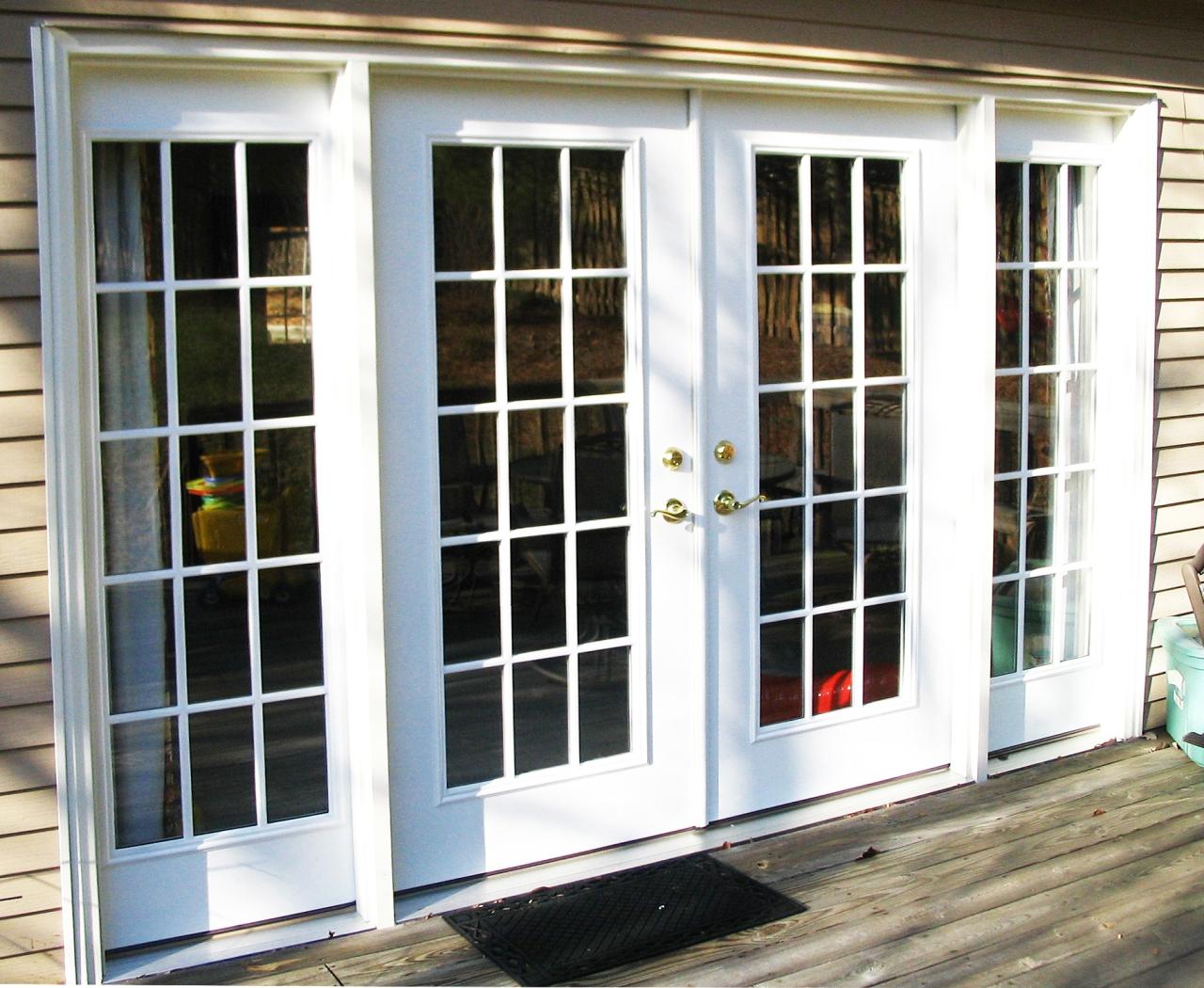
Source: compareintegrity.com
French windows, with their expansive glass panels and often floor-to-ceiling designs, present both opportunities and challenges regarding accessibility for people with disabilities. Careful consideration during design and installation is crucial to ensure these beautiful features don’t become barriers to inclusivity. This section will explore design considerations, potential challenges, and solutions for making French windows accessible.French windows, while aesthetically pleasing, can pose significant accessibility challenges if not designed and installed with accessibility in mind.
Their operation, including opening and closing mechanisms, and the threshold at the base can present obstacles for individuals using wheelchairs, walkers, or other mobility aids. Furthermore, the large glass panels can create safety concerns for those with visual impairments.
Design Considerations for Accessible French Windows
Several design elements can significantly enhance the accessibility of French windows. These include wider doorways to accommodate wheelchairs and other mobility devices, easily operable hardware such as lever handles instead of knobs, and low thresholds to minimize tripping hazards. The use of contrasting colors or textures around the window frame can also improve visibility for those with visual impairments.
Furthermore, incorporating safety features like laminated glass to reduce the risk of injury from shattered glass is a crucial safety measure. Finally, the selection of appropriate glazing can enhance energy efficiency and sound insulation, thereby improving comfort and usability.
Potential Accessibility Challenges Posed by French Windows
One major challenge is the operation of the window itself. Traditional handles can be difficult to grip and operate for people with limited hand strength or dexterity. The weight of the window sashes can also pose a problem, requiring significant effort to open and close. High thresholds create significant obstacles for wheelchair users and those with mobility impairments. The large expanse of glass can present a safety hazard to those with visual impairments, who might not easily perceive the presence of the glass.
Additionally, the lack of proper signage or tactile warnings can further exacerbate these issues.
Modifications and Adaptations for Improved Accessibility
Several modifications can address the accessibility challenges presented by French windows. Replacing traditional handles with lever handles or electronic opening mechanisms makes operation easier for people with limited dexterity. Lowering or removing thresholds eliminates a significant barrier for wheelchair users. Installing contrasting trim around the window frame improves visibility for those with visual impairments. Safety films can be applied to the glass to reduce the risk of injury from shattered glass in case of impact.
Finally, automatic opening systems, controlled by a switch or remote, provide an effortless and accessible solution. For example, a motorized system could be used to open and close the windows, controlled by a simple button or voice command.
Relevant Accessibility Standards for French Window Design
The importance of adhering to accessibility standards cannot be overstated. Meeting these standards ensures that French windows are usable and safe for everyone.
- ADA (Americans with Disabilities Act): Specifies requirements for accessibility in public accommodations and commercial facilities, including door widths and operable hardware.
- Building Codes (Vary by Location): Local building codes often incorporate accessibility standards, including requirements for thresholds, door clearances, and operable hardware. These codes should be consulted during the design and construction phases.
- International Accessibility Standards (e.g., WCAG): While not specifically focused on French windows, these standards provide broader guidance on accessibility principles, which can be applied to the design and construction of accessible French windows.
Concluding Remarks
French windows are more than just windows; they’re architectural elements that seamlessly blend indoor and outdoor spaces, enhancing both the aesthetics and functionality of a home. By understanding their history, design considerations, maintenance requirements, and energy efficiency implications, homeowners can make informed choices that maximize their benefits. Whether you’re renovating an existing home or building a new one, incorporating French windows can significantly elevate the living experience, offering breathtaking views, increased natural light, and a touch of timeless elegance.
Remember to consider accessibility and proper maintenance to ensure your French windows remain a beautiful and functional asset for years to come.
FAQ Resource
What is the average lifespan of French windows?
With proper maintenance, French windows can last for 20-30 years or even longer, depending on the materials used and the climate.
Can French windows be installed in any type of home?
Generally, yes, but structural considerations and local building codes need to be assessed before installation. Some older homes may require more extensive framing adjustments.
Are French windows more expensive than standard windows?
Typically, yes, due to their larger size, more complex construction, and often higher-quality materials.
How do I prevent condensation on French windows?
Ensure proper ventilation, use energy-efficient glazing, and consider adding weather stripping to seal any gaps.
Can French windows be soundproofed?
Yes, using specialized glazing and proper installation techniques can significantly reduce noise transmission.
